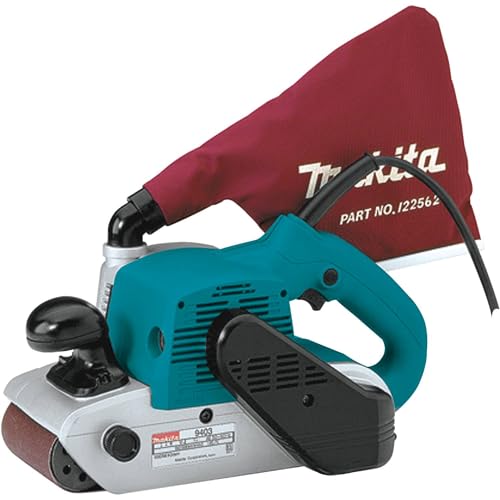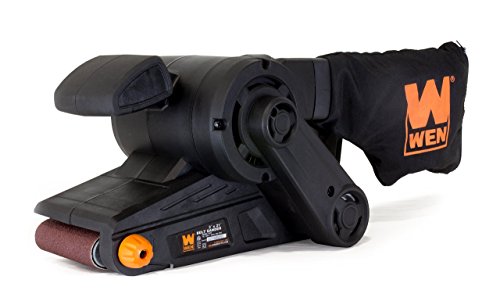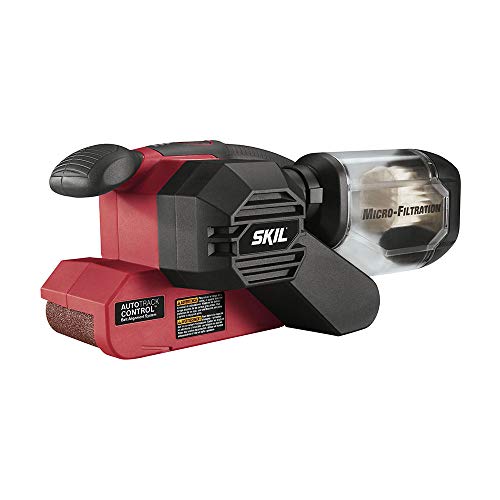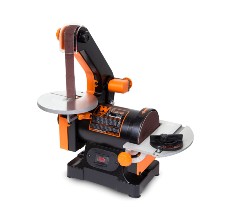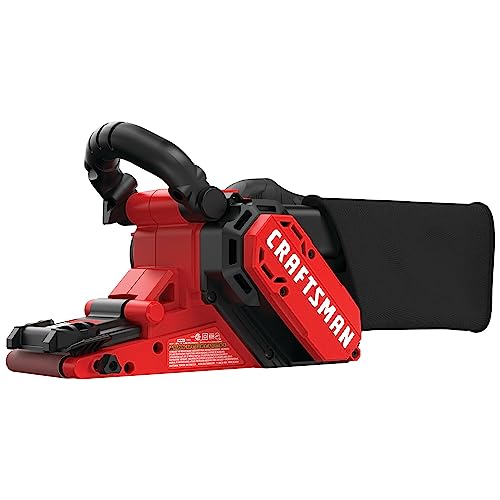Best Belt Sanders to Take Your Sanding Projects To the Next Level

When it comes to woodworking projects, there are numerous air compressor tools that you can use to do your work efficiently, but nothing beats the use of power tools, which cut down on the time it takes for you to finish your projects, and also deliver more smoothness and a better finish to your work. Often, you need to carry out the process of sanding to smoothen out wooden workpieces, usually after they have been cut.
Earlier, sanding was only done manually with sandpaper, which not only took a long time, but you had to put in a lot of effort to receive the desired result. However, all that changed when electric sanders were invented, particularly the belt sander, which is one of the most popular and commonly used tools for sanding.
Whether you are into professional woodworking and carpentry, or you like to work on DIY projects, a belt sander provides you with the perfect combination of power and smoothness that you need to get a refined finish. If you are looking to buy a new belt sander for your workshop, we have some of the best options that might be of help to you.
We have evaluated and examined hundreds of belt sanders, which has led us to the five best belt sanders of 2024. We have also included a buying guide that will help you choose the best belt sander for your sanding purposes.
Our Top Picks
- Best Overall: Makita 9403 4” X 24” Belt Sander Shop Now ➔
- Runner Up: WEN Corded Belt Sander Shop Now ➔
- Honorable Mention: SKIL Belt Sander Shop Now ➔
- Contender: WEN 6515T 1 in. x 30 in. Belt Sander Shop Now ➔
- CRAFTSMAN Belt Sander Shop Now ➔
Best Belt Sander Worth Considering for 2024
Best Overall
Our first choice is the Makita 9403 Belt Sander, which is known to have the lowest noise rating among its competitors. This belt sander has a 4” by 24” belt that rotates at a fast speed of 1,640 feet per minute and is used for fast and precise sanding jobs. It has a labyrinth design that keeps the motor and its bearings from moisture, sawdust, and contamination. It has a large rear handle that provides a secure grip, as well as a rounded front grip that allows for more control.
This belt sander is lightweight and can be carried around for longer projects easily. It also has a dust extraction port with a removable dust collector bag to prevent sawdust flying everywhere.
Pros
- One of the quietest belt sanders
- Has a wide belt that provides easier material removal
- Vented design provides airflow to the motor
Cons
- Doesn’t have variable speed control
Runner Up
Next up is the WEN 6321 Corded Belt Sander with Dust Bag, which is a powerful and reliable belt sander that can be used to sand various surfaces easily. It has a high-performance 7 Amp motor that provides an impressive speed of 13 feet per second. This allows you to sand different workpieces with much more smoothness. The belt sander has a compact and lightweight construction that makes it easier to hold while sanding. It has a trigger that you can use to control the speed, as well as a trigger lock that you can use to hold the speed.
This belt sander allows you to easily change the belt without any tool, and it also has a detachable dust bag that you can remove when it is full of sawdust.
Pros
- Comes with an 80-grit sanding belt
- Lockable trigger allows you to fix speed
- Provides smooth finish over various surfaces
Cons
- Doesn’t come with any storage case
Honorable Mention
The SKIL 7510-01 Sandcat Belt Sander has a unique and advanced construction, and it has a medium grit 3” x 18” belt that allows you to sand different surfaces, including rough edges and curves. It features a pressure control technology that indicates when you are applying too much pressure on a surface. Plus, the Auto Track system keeps the belt from sliding or moving from the track.
The belt sander features a transparent dust canister with a micro-filtration system that captures all kinds of dust particles so that they don’t fly into the machine. It has a top handle that allows for a good grip and better control on the sanding. It also has a single lever that allows for easy belt changing.
Pros
- 120-volt powerful motor ensures a smooth performance
- Pressure control technology indicates when excess pressure is applied
Cons
- Tends to overheat if used excessively
Contender
The WEN 6515T Belt Sander is a highly useful 2-in-1 machine that features a 1” by 30” belt, along with a 5” sanding disc. Both of them can be used for a wide range of sanding applications. It has a powerful 2.3A motor that moves the belt at 3160 feet per minute and the sanding disc at 3450 RPM. It has a sturdy and heavy-duty construction with textured feet that sit securely on your workbench and also prevent wobbling or movement due to vibration.
The belt sander contains two individual dust ports for both the sanding belt and disc, which blows all sorts of dust particles away from the machine.
Pros
- Features a sanding belt and sanding disc
- Heavy-duty construction with textured feet
Cons
- Doesn’t come with dust collection bags
The CRAFTSMAN Belt Sander is a high-quality sanding machine that features a 7 Amp motor that provides a maximum speed of 800 RPM, thus allowing for fast material removal. It features a 3” x 21” coarse grit belt that is installed at an angled design and allows for sanding on various surfaces, including workpieces that have been joined together. Moreover, the belt sander is also equipped with a molded handle that you can comfortably hold while sanding.
This belt sander also features an efficient dust collection system with a removable dust bag that comes in the package. Moreover, it also has a tool-free belt release feature for easy changing.
Pros
- Maximum speed of 800 RPM ensures faster sanding
- Easy to remove sanding belt with release lever
- Angled belt design helps in sanding various surfaces
Cons
- Has a noisy operation
Best Belt Sanders Buying Guide
What Is a Belt Sander?
A belt sander is a multipurpose sanding tool that can be used for not just sanding, but also for trimming, leveling, rounding, and shaping. They have a highly powerful motor and can also be used with coarse-grit sandpapers, which allows them to remove material much faster. In belt sanders, the motor moves the sanding belt in a linear fashion, which allows you to cover more surface area and provide a better grain.
A belt sander is highly useful for professional and experienced woodworkers, as well as DIY enthusiasts who like to work on different projects in their homes. They are preferred over other tools because of their faster operation and greater power, and once you have polished your skills with the belt sander, you can work on small and large projects with accuracy and precision. With this guide, you will find the best belt sander that will suit your needs.
How To Use a Belt Sander
The belt sander is one of the easiest tools to use for both experienced and inexperienced woodworkers, and its basic function involves holding down the moving sanding belt on top of the surface of the workpiece you want to sand. Before you start anything, make sure to wear safety gloves and safety goggles, so that your hands and eyes are protected from the sander’s operation. It is also wise to invest in a pair of safety headphones since they can get quite noisy. You may also consider using a dust bag or another dust collection device to collect the sawdust that the belt sander will produce. Breathing in the dust from the belt sander can be very harmful to your health.
The next step is to place the piece of wood you want to sand on the bench, with the side that you want to smoothen or level facing upwards. Then, grab the handle of your belt sander and hold it a little further from the surface. Make sure that the sanding belt isn’t touching anything when you turn it on. Also ensure that the trigger, if present, isn’t on or at full speed when you press the power switch.
Once you turn on the belt sander, the belt will start to move slowly, and then it will reach its full speed. Hold the belt sander with both hands and slowly bring it towards the workpiece, making sure not to press it down. Slowly maneuver the belt sander from one end to the other, and also make sure that the cord is out of the way and safely managed.
For a video tutorial, check out this video from HouseImprovements:

Things To Consider Before Buying a Belt Sander
Just like we have evaluated numerous belt sanders to handpick the best ones, you can also make use of the following factors to decide which one is most suitable for you.
Type
There are numerous types of belt sanders that you can find, and they can be divided into two basic types: stationary belt sanders that are clamped on a benchtop, and handheld belt sanders that are portable and can be carried. A stationary belt sander is used in workshops where a lot of carpentry work is done, whereas a handheld belt sander can be carried around for projects in which you have to travel somewhere and can’t take your stationary belt sander, as well as home and DIY projects. You can choose between the two depending on the purpose for which you will have to use it.
Belt size
The belt size is another key factor that you must keep in mind when choosing the best belt sander, since it is the most important component of the machine. There are numerous belt sizes that you can choose from. In stationary belt sanders, the belt sizes usually range from 4” x 36” to 6” x 48”. Moreover, the handheld belt sanders feature belts that range from 3” x 21” to 4” x 24”. If you need a smaller belt that can be used to reach tight spaces, you can also find a ½” x 18” belt. A mini belt sander can get into smaller nooks and crannies that a typical sized one cannot. However, if you have large surfaces to cover, a mini belt sander may not be the best option. Make sure to choose a belt sander that has the appropriate belt size.
Power
Stationary belt sanders are only found with corded power, while you can find handheld belt sanders with both corded and cordless capabilities. Naturally, cordless belt sanders have lower power than corded variants. They are fitted with 18 or 20-volt lithium-ion batteries. Most of the handheld belt sanders have a 6 or 12 amp motor that is sufficient for most sanding projects. However, if you have to work with larger wood pieces, you will need something with more power.
Speed
The speed of a belt sander refers to how fast it rotates the belt, and this is measured in feet per second, while most manufacturers also show the value in rotations per minute, or RPM. Most of the belt sanders have a fixed speed, generally ranging between 1500 and 2000 RPM. Plus, you can find belt sanders with two-speed settings: low and high. Moreover, there are belt sanders with variable speed settings, which are usually controlled by a trigger. Ideally, variable speed settings are perfect for you if you have to work on a variety of sanding jobs with your belt sander regularly.
Additional features
You can also have a look at certain additional features when choosing the best belt sander, one of which is the dust extraction system. It makes use of a vacuum that draws dust particles and blows them out of the port at the back, where you can attach a dust collection bag to collect all of them. Moreover, some belt sanders also have filtration features, auto track systems, and many other useful features.
People Also Asked
What are Sanding Belts Made From?
Sanding belts are made from different materials, which include aluminum oxide, ceramic, silicon carbide, and zirconia. These materials are suitable for creating an abrasive texture that is suitable for sanding.
How to choose the right grit value?
There are different types of grit value that you can choose, and the smaller the grit value, the coarser the sanding belt will be. You can choose grits up to 60 for removing material, while you can go up to 120 for achieving smooth surfaces.
What materials can be sanded with a belt sander?
Belt sanders can be used to remove material from wood and non-ferrous metals, such as aluminum.
Article Contributors
The Woodsmith Review Team’s product reviews and in-depth guides are here to help you choose the best tools and gear to build great-looking projects confidently. Woodsmith is reader-supported: When you buy through links on our site, we may earn an affiliate commission. Large language models (like Artificial Intelligence) may have been used in the research and creation of the content.
Inquiries regarding specific articles or product testing should be sent to aimperiapt@gmail.com

